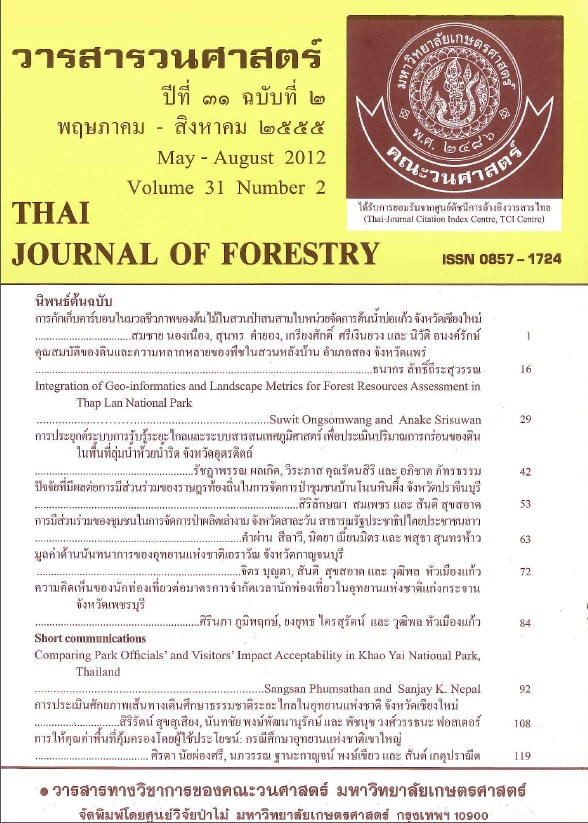การประยุกต์ระบบการรับรู้ระยะไกลและระบบสารสนเทศภูมิศาสตร์ เพื่อประเมินปริมาณการกร่อนของดิน ในพื้นที่ลุ่มน้ำห้วยน้ำริด จังหวัดอุตรดิตถ์
Main Article Content
บทคัดย่อ
การศึกษาครั้งนี้มีวัตถุประสงค์เพื่อใช้ภาพดาวเทียม Landsat-5 TM ในการติดตามการใช้ประโยชน์ที่ดินในพื้นที่ลุ่มน้ำห้วยน้ำริด จังหวัดอุตรดิตถ์ ด้วยวิธี Supervised classification แบบ Maximum likelihood และกำหนดพื้นที่ตัวแทน (Training area) และเพื่อประเมินค่าปริมาณการกร่อนของดิน โดยใช้แบบจำลองสูญเสียดินสากล (Universal Soil Loss Equation: USLE) ทั้งนี้ได้ดำเนินรวบรวมข้อมูลปริมาณน้ำฝน ความคงทนต่อการกร่อนของดิน การใช้ประโยชน์ที่ดิน และความสูงของภูมิประเทศ ร่วมกับข้อมูลในระบบสารสนเทศทางภูมิศาสตร์ (Geographic Information System: GIS) และในการศึกษาครั้งนี้ต้องการให้แสดงถึง ขนาดช่องกริด 30 × 30 เมตร ซึ่งมีขนาดพื้นที่ขนาด 1655.820 × 1655.820 เมตร หรือ 274.170 ตารางกิโลเมตร
ผลการศึกษา พบว่า การใช้ประโยชน์ของที่ดินในพื้นที่ลุ่มน้ำห้วยน้ำริด แบ่งได้ 10 ประเภท ได้แก่ ป่าดิบเขา ป่าเบญจพรรณรุ่น ป่าเบญจพรรณ ป่าฟื้นฟูตามธรรมชาติ สวนกล้วย นาข้าว สวนป่าสัก ไร่ร้าง แหล่งชุมชน และแหล่งน้ำ ส่วนการปริมาณการกร่อนของดินในพื้นที่ลุ่มน้ำห้วยน้ำริด พบว่า พื้นที่ลุ่มน้ำมีการกร่อนโดยรวมอยู่ในระดับน้อย เท่ากับ 0.998 ตันต่อเฮกตาร์ต่อปี โดยพื้นที่ป่าเบญจพรรณมีการกร่อนของดินรุนแรงที่สุด เท่ากับ 75.656 ตันต่อเฮกตาร์ต่อปี หรือร้อยละ 27.595 ของพื้นที่ลุ่มน้ำ เนื่องจากพื้นที่ดังกล่าวมีสภาพเป็นป่าโปร่ง ซึ่งง่ายต่อการได้รับอิทธิพลจากน้ำฝนมาก และส่วนพื้นที่แหล่งชุมชน มีอัตราการกร่อนของดินอยู่ในระดับน้อย เท่ากับ 0.004 ตันต่อเฮกตาร์ต่อปี เนื่องจากเป็นบริเวณที่มีความลาดชันต่ำ เป็นพื้นที่ราบเป็นส่วนใหญ่
คำสำคัญ: ระบบการรับรู้ระยะไกล ระบบสารสนเทศภูมิศาสตร์ การกร่อนของดิน
Downloads
Article Details

อนุญาตภายใต้เงื่อนไข Creative Commons Attribution-NonCommercial-NoDerivatives 4.0 International License.
ข้าพเจ้าและผู้เขียนร่วม (ถ้ามี) ขอรับรองว่า ต้นฉบับที่เสนอมานี้ยังไม่เคยได้รับการตีพิมพ์และไม่ได้อยู่ในระหว่างกระบวนการพิจารณาตีพิมพ์ลงในวารสารหรือสิ่งตีพิมพ์อื่นใด ข้าพเจ้าและผู้เขียนร่วม (ถ้ามี) ยอมรับหลักเกณฑ์และเงื่อนไขการพิจารณาต้นฉบับ ทั้งยินยอมให้กองบรรณาธิการมีสิทธิ์พิจารณาและตรวจแก้ต้นฉบับได้ตามที่เห็นสมควร พร้อมนี้ขอมอบลิขสิทธิ์ผลงานที่ได้รับการตีพิมพ์ให้แก่วารสารวนศาสตร์ คณะวนศาสตร์ มหาวิทยาลัยเกษตรศาสตร์ กรณีมีการฟ้องร้องเรื่องการละเมิดลิขสิทธิ์เกี่ยวกับภาพ กราฟ ข้อความส่วนใดส่วนหนึ่ง หรือ ข้อคิดเห็นที่ปรากฏในผลงาน ให้เป็นความรับผิดชอบของข้าพเจ้าและผู้เขียนร่วม (ถ้ามี) แต่เพียงฝ่ายเดียว และหากข้าพเจ้าและผู้เขียนร่วม (ถ้ามี) ประสงค์ถอนบทความในระหว่างกระบวนการพิจารณาของทางวารสาร ข้าพเจ้าและผู้เขียนร่วม (ถ้ามี) ยินดีรับผิดชอบค่าใช้จ่ายทั้งหมดที่เกิดขึ้นในกระบวนการพิจารณาบทความนั้น”


